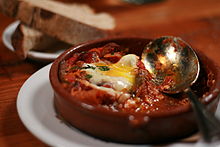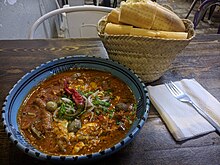| Revision as of 01:28, 13 May 2024 editLEvalyn (talk | contribs)Autopatrolled, Extended confirmed users, New page reviewers5,651 edits →Variations: original info failed verification, updating with what Raviv actually saysTag: Visual edit← Previous edit | Revision as of 00:37, 14 May 2024 edit undoM.Bitton (talk | contribs)Extended confirmed users54,923 edits removed the remote origin claim from the lead and adjusted the origin per what all the sources stateNext edit → | ||
| Line 22: | Line 22: | ||
| ] | ] | ||
| '''Shakshouka''' ({{lang-ar|شكشوكة}} : šakšūkah, also spelled ''shakshuka'' or ''chakchouka'') is a ]<ref name="Gil Marks">{{cite book|author=Gil Marks|title=Encyclopedia of Jewish Food |url=https://books.google.com/books?id=gFK_yx7Ps7cC&pg=PA1673|year=2010|publisher=HMH |isbn=978-0-544-18631-6|page=1673}}</ref><ref name=" |
'''Shakshouka''' ({{lang-ar|شكشوكة}} : šakšūkah, also spelled ''shakshuka'' or ''chakchouka'') is a ]<ref name="Gil Marks">{{cite book|author=Gil Marks|title=Encyclopedia of Jewish Food |url=https://books.google.com/books?id=gFK_yx7Ps7cC&pg=PA1673|year=2010|publisher=HMH |isbn=978-0-544-18631-6|page=1673}}</ref><ref name="Sienna" /><ref name="Buccini" /> dish of eggs ] in a sauce of tomatoes, olive oil, peppers, onion, and garlic, commonly spiced with ], ] and ]. Shakshouka is a popular dish throughout ] and the ].<ref name="Memo">{{Cite news |last=Salah |first=Maha |date=14 February 2020 |title=Shakshuka |work=] |url=https://www.middleeastmonitor.com/20200214-shakshuka/}}</ref> | ||
| ==Etymology== | ==Etymology== | ||
| The word ''shakshouka'' ({{lang-ar|شكشوكة}}) is a ]<ref>{{Cite book |url=https://books.google.com/books?id=-fIqCgAAQBAJ&pg=PT42 |title=Mediterranean Cooking for Diabetics: Delicious Dishes to Control or Avoid Diabetes |last=Ellis |first=Robin |date=2016-03-03 |publisher=Little, Brown Book Group |isbn=9781472136381 |language=en |access-date=2017-11-15 |archive-url=https://web.archive.org/web/20171116081410/https://books.google.ch/books?id=-fIqCgAAQBAJ&pg=PT42&dq= |archive-date=2017-11-16 |url-status=live }}</ref> term for "a mixture".<ref name=":1">{{Cite book |url=https://books.google.com/books?id=tyrvBQAAQBAJ&pg=PA41 |title=The CSA Cookbook: No-Waste Recipes for Cooking Your Way Through a Community Supported Agriculture Box, Farmers' Market, Or Backyard Bounty |last=Ly |first=Linda |date=2015-03-20 |publisher=Voyageur Press |isbn=9780760347294 |language=en |access-date=2017-11-15 |archive-url=https://web.archive.org/web/20171116131555/https://books.google.ch/books?id=tyrvBQAAQBAJ&pg=PA41&dq= |archive-date=2017-11-16 |url-status=live }}</ref><ref>{{Cite book |url=https://books.google.com/books?id=L3BCDgAAQBAJ&pg=PT187 |title=The World's Best Superfoods |last=Planet |first=Lonely |date=2017-03-01 |publisher=Lonely Planet |isbn=9781787010369 |language=en |access-date=2017-11-15 |archive-url=https://web.archive.org/web/20171116081803/https://books.google.ch/books?id=L3BCDgAAQBAJ&pg=PT187&dq= |archive-date=2017-11-16 |url-status=live }}</ref><ref>{{Cite book |url=https://books.google.com/books?id=NWmWBgAAQBAJ&pg=PA43 |title=Mug Meals: More Than 100 No-Fuss Ways to Make a Delicious Microwave Meal in Minutes |last=Bilderback |first=Leslie |date=2015-09-01 |publisher=St. Martin's Press |isbn=9781466875210 |language=en |access-date=2017-11-15 |archive-url=https://web.archive.org/web/20171116131301/https://books.google.ch/books?id=NWmWBgAAQBAJ&pg=PA43&dq= |archive-date=2017-11-16 |url-status=live }}</ref><ref>{{Cite news |last=Jakob |first=Ben |date=2017-06-06 |title=How Shakshuka, Israel's Famous Breakfast Dish, Took the World By Storm |work=Culture Trip |url=https://theculturetrip.com/middle-east/israel/articles/how-shakshuka-israels-famous-breakfast-dish-took-the-world-by-storm/ |url-status=live |access-date=2017-11-15 |archive-url=https://web.archive.org/web/20171116084248/https://theculturetrip.com/middle-east/israel/articles/how-shakshuka-israels-famous-breakfast-dish-took-the-world-by-storm/ |archive-date=2017-11-16}}</ref> According to Mary Fitzgerald, the word is allegedly believed to come from the ],<ref name="Irish">{{Cite web |url=https://www.irishtimes.com/life-and-style/food-and-drink/shakshuka-all-mixed-up-over-a-brilliant-breakfast-1.4526350 |title=Shakshuka: All mixed up over a brilliant breakfast |publisher=The Irish Times |date=Apr 24, 2021 |first=Mary |last=Fitzgerald |access-date=2021-09-09}}</ref> although most sources agree on the term's Arabic origin. In Morocco, it is referred to as {{Transliteration|ary|bīḍ w-maṭiša}} ({{Lang|ary|بيض ومطيشة}} "egg and tomato").<ref>{{Cite web|date=2012-10-16|title=وداعا "البيض ومطيشة"|url=https://www.hespress.com/وداعا-البيض-ومطيشة-104064.html|access-date=2022-01-26|website=Hespress - هسبريس جريدة إلكترونية مغربية|language=ar}}</ref> The term ''shakshouka'' may have derived from "shak", another ] word meaning "to combine things together", as the dish combines tomatoes, chilies and eggs.<ref name=" |
The word ''shakshouka'' ({{lang-ar|شكشوكة}}) is a ]<ref>{{Cite book |url=https://books.google.com/books?id=-fIqCgAAQBAJ&pg=PT42 |title=Mediterranean Cooking for Diabetics: Delicious Dishes to Control or Avoid Diabetes |last=Ellis |first=Robin |date=2016-03-03 |publisher=Little, Brown Book Group |isbn=9781472136381 |language=en |access-date=2017-11-15 |archive-url=https://web.archive.org/web/20171116081410/https://books.google.ch/books?id=-fIqCgAAQBAJ&pg=PT42&dq= |archive-date=2017-11-16 |url-status=live }}</ref> term for "a mixture".<ref name=":1">{{Cite book |url=https://books.google.com/books?id=tyrvBQAAQBAJ&pg=PA41 |title=The CSA Cookbook: No-Waste Recipes for Cooking Your Way Through a Community Supported Agriculture Box, Farmers' Market, Or Backyard Bounty |last=Ly |first=Linda |date=2015-03-20 |publisher=Voyageur Press |isbn=9780760347294 |language=en |access-date=2017-11-15 |archive-url=https://web.archive.org/web/20171116131555/https://books.google.ch/books?id=tyrvBQAAQBAJ&pg=PA41&dq= |archive-date=2017-11-16 |url-status=live }}</ref><ref>{{Cite book |url=https://books.google.com/books?id=L3BCDgAAQBAJ&pg=PT187 |title=The World's Best Superfoods |last=Planet |first=Lonely |date=2017-03-01 |publisher=Lonely Planet |isbn=9781787010369 |language=en |access-date=2017-11-15 |archive-url=https://web.archive.org/web/20171116081803/https://books.google.ch/books?id=L3BCDgAAQBAJ&pg=PT187&dq= |archive-date=2017-11-16 |url-status=live }}</ref><ref>{{Cite book |url=https://books.google.com/books?id=NWmWBgAAQBAJ&pg=PA43 |title=Mug Meals: More Than 100 No-Fuss Ways to Make a Delicious Microwave Meal in Minutes |last=Bilderback |first=Leslie |date=2015-09-01 |publisher=St. Martin's Press |isbn=9781466875210 |language=en |access-date=2017-11-15 |archive-url=https://web.archive.org/web/20171116131301/https://books.google.ch/books?id=NWmWBgAAQBAJ&pg=PA43&dq= |archive-date=2017-11-16 |url-status=live }}</ref><ref>{{Cite news |last=Jakob |first=Ben |date=2017-06-06 |title=How Shakshuka, Israel's Famous Breakfast Dish, Took the World By Storm |work=Culture Trip |url=https://theculturetrip.com/middle-east/israel/articles/how-shakshuka-israels-famous-breakfast-dish-took-the-world-by-storm/ |url-status=live |access-date=2017-11-15 |archive-url=https://web.archive.org/web/20171116084248/https://theculturetrip.com/middle-east/israel/articles/how-shakshuka-israels-famous-breakfast-dish-took-the-world-by-storm/ |archive-date=2017-11-16}}</ref> According to Mary Fitzgerald, the word is allegedly believed to come from the ],<ref name="Irish">{{Cite web |url=https://www.irishtimes.com/life-and-style/food-and-drink/shakshuka-all-mixed-up-over-a-brilliant-breakfast-1.4526350 |title=Shakshuka: All mixed up over a brilliant breakfast |publisher=The Irish Times |date=Apr 24, 2021 |first=Mary |last=Fitzgerald |access-date=2021-09-09}}</ref> although most sources agree on the term's Arabic origin. In Morocco, it is referred to as {{Transliteration|ary|bīḍ w-maṭiša}} ({{Lang|ary|بيض ومطيشة}} "egg and tomato").<ref>{{Cite web|date=2012-10-16|title=وداعا "البيض ومطيشة"|url=https://www.hespress.com/وداعا-البيض-ومطيشة-104064.html|access-date=2022-01-26|website=Hespress - هسبريس جريدة إلكترونية مغربية|language=ar}}</ref> The term ''shakshouka'' may have derived from "shak", another ] word meaning "to combine things together", as the dish combines tomatoes, chilies and eggs.<ref name="Memo" /> | ||
| ==Origins== | ==Origins== | ||
| ], noting some similarities with the Ottoman dish ], suggests that shakshouka spread to the Maghreb through the influence of the Ottoman Empire.<ref name="Gil Marks" /><ref name=" |
], while noting some similarities with the Ottoman dish ], suggests that shakshouka evolved from ] which spread to the Maghreb through the influence of the Ottoman Empire.<ref name="Gil Marks" /> Anthony Buccini noted similarities between a wider range of vegetable stews. He and ] conclude that both shakshouka and menemen, among other dishes like ] and ], are members of a wider family of vegetable stews of common ancestry appearing throughout the western Mediterranean.<ref name="Sienna">{{Cite book |last=Sienna |first=Noam |url=https://www.jstor.org/stable/10.7560/324578 |title=Making Levantine Cuisine: Modern Foodways of the Eastern Mediterranean |date=2021 |publisher=University of Texas Press |isbn=978-1-4773-2457-8 |editor-last=Gaul |editor-first=Anny |pages=170-183 |chapter=Shakshūka for All Seasons: Tunisian Jewish Foodways at the Turn of the Twentieth Century |doi=10.7560/324578.15 |editor-last2=Pitts |editor-first2=Graham Auman |editor-last3=Valosik |editor-first3=Vicki}}</ref><ref name="Buccini">{{Cite book |last=Buccini |first=Anthony F. |title=Authenticity in the Kitchen: Proceedings of the Oxford Symposium on Food and Cookery 2005 |publisher=Prospect Books |year=2006 |editor-last=Hosking |editor-first=Richard |pages=132-145 |chapter=Western Mediterranean Vegetable Stews and the Integration of Culinary Exotica}}</ref> | ||
| The migration of |
The migration of Maghrebi Jews in the 1950s brought the dish to Israel, where it was subsequently widely adopted despite not being previously present in Palestinian or Levantine cuisine.<ref name="Gil Marks" /><ref name="Sienna" /> | ||
| ==Variations== | ==Variations== | ||
Revision as of 00:37, 14 May 2024
Maghrebi dish of eggs poached in a sauce For the shredded flatbread and chickpea dish, see Chakhchoukha. For the Turkish eggplant dish, see Şakşuka. For the documentary film, see The Shakshuka System. Shakshouka in a cast iron pan Shakshouka in a cast iron pan | |
| Alternative names | Shakshuka, chakchouka |
|---|---|
| Type | Main dish |
| Place of origin | Ottoman North Africa |
| Main ingredients | Tomatoes, harissa, eggs, olive oil |

Shakshouka (Template:Lang-ar : šakšūkah, also spelled shakshuka or chakchouka) is a Maghrebi dish of eggs poached in a sauce of tomatoes, olive oil, peppers, onion, and garlic, commonly spiced with cumin, paprika and cayenne pepper. Shakshouka is a popular dish throughout North Africa and the Middle East.
Etymology
The word shakshouka (Template:Lang-ar) is a Maghrebi Arabic term for "a mixture". According to Mary Fitzgerald, the word is allegedly believed to come from the Berber languages, although most sources agree on the term's Arabic origin. In Morocco, it is referred to as bīḍ w-maṭiša (بيض ومطيشة "egg and tomato"). The term shakshouka may have derived from "shak", another Arabic word meaning "to combine things together", as the dish combines tomatoes, chilies and eggs.
Origins
Gil Marks, while noting some similarities with the Ottoman dish menemen, suggests that shakshouka evolved from Şakşuka which spread to the Maghreb through the influence of the Ottoman Empire. Anthony Buccini noted similarities between a wider range of vegetable stews. He and Noam Sienna conclude that both shakshouka and menemen, among other dishes like piperade and ratatouille, are members of a wider family of vegetable stews of common ancestry appearing throughout the western Mediterranean.
The migration of Maghrebi Jews in the 1950s brought the dish to Israel, where it was subsequently widely adopted despite not being previously present in Palestinian or Levantine cuisine.
Variations


Many variations of the basic sauce are possible, varying in spice and sweetness. Some cooks add preserved lemon, salty sheep milk cheeses, olives, harissa or a spicy sausage such as chorizo or merguez. Shakshouka is made with eggs, which are commonly poached but can also be scrambled, like in the Turkish menemen.
In Algeria, shakshouka is commonly eaten as a side dish, and there are countless variations of it, each with their own unique blend of ingredients. One such variation is hmiss, which is often served alongside traditional kesra bread. Hmiss typically includes grilled peppers, tomatoes, and garlic. In Tunisia, a similar dish called slata meshouia is enjoyed, but it differs from hmiss with the addition of onions, cumin and tuna.
Some variations of shakshouka can be made with lamb mince, toasted whole spices, yogurt and fresh herbs. Spices can include ground coriander, caraway, paprika, cumin and cayenne pepper. Tunisian cooks may add potatoes, broad beans, artichoke hearts or courgettes to the dish. The North African dish matbukha can be used as a base for shakshouka.
In 1979, a cookbook aimed at soldiers in the Israel Defense Forces suggested making shakshouka as a way to deal with loof (a kosher canned corn beef), an often-disliked part of the standard rations.
Because eggs are the main ingredient, it often appears on breakfast menus in English-speaking countries, but in the Arab world as well as Israel, it is also a popular evening meal, and like hummus and falafel, is a Levantine regional favorite. On the side, pickled vegetables and North African sausage called merguez might be served, or simply bread, with mint tea.
In Jewish culture, a large batch of tomato stew is made for the Sabbath dinner and the leftovers used the following morning to make a breakfast shakshouka with eggs. In Andalusian cuisine, the dish is known as huevos a la flamenca; this version includes chorizo and serrano ham. In Italian cuisine, there is a version of this dish called uova in purgatorio (eggs in purgatory) that adds garlic, basil or parsley.
See also
References
- ^ Gil Marks (2010). Encyclopedia of Jewish Food. HMH. p. 1673. ISBN 978-0-544-18631-6.
- ^ Sienna, Noam (2021). "Shakshūka for All Seasons: Tunisian Jewish Foodways at the Turn of the Twentieth Century". In Gaul, Anny; Pitts, Graham Auman; Valosik, Vicki (eds.). Making Levantine Cuisine: Modern Foodways of the Eastern Mediterranean. University of Texas Press. pp. 170–183. doi:10.7560/324578.15. ISBN 978-1-4773-2457-8.
- ^ Buccini, Anthony F. (2006). "Western Mediterranean Vegetable Stews and the Integration of Culinary Exotica". In Hosking, Richard (ed.). Authenticity in the Kitchen: Proceedings of the Oxford Symposium on Food and Cookery 2005. Prospect Books. pp. 132–145.
- ^ Salah, Maha (14 February 2020). "Shakshuka". Middle East Monitor.
- Ellis, Robin (2016-03-03). Mediterranean Cooking for Diabetics: Delicious Dishes to Control or Avoid Diabetes. Little, Brown Book Group. ISBN 9781472136381. Archived from the original on 2017-11-16. Retrieved 2017-11-15.
- Ly, Linda (2015-03-20). The CSA Cookbook: No-Waste Recipes for Cooking Your Way Through a Community Supported Agriculture Box, Farmers' Market, Or Backyard Bounty. Voyageur Press. ISBN 9780760347294. Archived from the original on 2017-11-16. Retrieved 2017-11-15.
- Planet, Lonely (2017-03-01). The World's Best Superfoods. Lonely Planet. ISBN 9781787010369. Archived from the original on 2017-11-16. Retrieved 2017-11-15.
- Bilderback, Leslie (2015-09-01). Mug Meals: More Than 100 No-Fuss Ways to Make a Delicious Microwave Meal in Minutes. St. Martin's Press. ISBN 9781466875210. Archived from the original on 2017-11-16. Retrieved 2017-11-15.
- Jakob, Ben (2017-06-06). "How Shakshuka, Israel's Famous Breakfast Dish, Took the World By Storm". Culture Trip. Archived from the original on 2017-11-16. Retrieved 2017-11-15.
- Fitzgerald, Mary (Apr 24, 2021). "Shakshuka: All mixed up over a brilliant breakfast". The Irish Times. Retrieved 2021-09-09.
- "وداعا "البيض ومطيشة"". Hespress - هسبريس جريدة إلكترونية مغربية (in Arabic). 2012-10-16. Retrieved 2022-01-26.
- "Shakshuka recipe". The Guardian. February 18, 2012.
- Joel Lurie Grishaver (2008). Artzeinu: An Israel Encounter.
- ^ Gil Marks, Encyclopedia of Jewish Food, Houghton Mifflin Harcourt, 2010, ISBN 9780470391303, s.v., p. 547
- Gordon, Peter (2018-06-03). "Peter Gordon's lamb shakshouka recipe". The Guardian. ISSN 0261-3077. Retrieved 2018-07-21.
- "Shakshouka Recipe – Tunisian Recipes". PBS Food. 2015-03-12. Retrieved 2018-07-21.
- Clark, Melissa. "Shakshuka With Feta Recipe". NYT Cooking. Retrieved 2018-07-21.
- Roden, Claudia (1996). The Book of Jewish Food: An Odyssey from Samarkand to New York. Knopf. p. 512. ISBN 9780394532585.
- Gur, Janna (2014). Jewish Soul Food: From Minsk to Marrakesh.
- Raviv, Yael (November 2015). Falafel Nation: Cuisine and the Making of National Identity in Israel. University of Nebraska Press. p. 172. ISBN 978-0-8032-9023-5.
- Clifford-Smith, Stephanie (2011-06-07). "Three of a kind ... shakshouka". Sydney Morning Herald. Archived from the original on 2017-08-08. Retrieved 2017-08-07.
- Josephs, Bernard (2009-10-08). "Shakshuka: Israel's hottest breakfast dish". The Jewish Chronicle. Archived from the original on 2017-08-08. Retrieved 2017-08-07.
- Ashkenazi, Michael (2020). Food Cultures of Israel: Recipes, Customs, and Issues. p. 89.
- Tish, Ben (2019). Moorish: Vibrant Recipes from the Mediterranean. Bloomsbury. p. 46. ISBN 9781472958082.
- "Uova in purgatorio". La Cucina italiana (in Italian). 20 August 2015. Retrieved 2023-06-24.
External links
 Quotations related to Shakshouka at Wikiquote
Quotations related to Shakshouka at Wikiquote
| Cuisine of Tunisia | |
|---|---|
| Breads, dishes, and soups | |
| Ingredients | |
| Beverages | |
| Desserts and pastries | |
| Related | |
| Algerian cuisine | |
|---|---|
| Dishes | |
| Soups | |
| Brochettes | |
| Ingredients | |
| Beverages | |
| Desserts and pastries | |
| Related | |
| Jewish cuisine | |||||||||||
|---|---|---|---|---|---|---|---|---|---|---|---|
| History | |||||||||||
| Types | |||||||||||
| Religious dietary laws and related terms | |||||||||||
| Chefs | |||||||||||
| Religious foods | |||||||||||
| Breads |
| ||||||||||
| Sweets |
| ||||||||||
| Pastries | |||||||||||
| Fried foods |
| ||||||||||
| Dumplings, pastas and grain dishes |
| ||||||||||
| Casseroles and savory baked dishes | |||||||||||
| Snacks and other baked goods | |||||||||||
| Sandwiches | |||||||||||
| Egg dishes | |||||||||||
| Meat dishes | |||||||||||
| Fish dishes | |||||||||||
| Salads and pickles | |||||||||||
| Vegetable dishes | |||||||||||
| Soups and stews | |||||||||||
| Cheeses and other dairy products | |||||||||||
| Condiments, dips and sauces | |||||||||||
| Beverages | |||||||||||
| Herbs, spices and seasonings | |||||||||||
| Eateries | |||||||||||
| Related lists | |||||||||||
| Moroccan cuisine | |
|---|---|
| Dishes (list) | |
| Brochettes | |
| Ingredients | |
| Soups | |
| Breads | |
| Desserts & pastries | |
| Beverages | |
| Related cuisines | |
- Arab cuisine
- Libyan cuisine
- Tunisian cuisine
- Algerian cuisine
- Moroccan cuisine
- Israeli cuisine
- Egyptian cuisine
- Yemeni cuisine
- Egg dishes
- National dishes
- Mizrahi Jewish cuisine
- Sephardi Jewish cuisine
- Maghrebi cuisine
- Ottoman cuisine
- Spanish cuisine
- Italian cuisine
- Meze
- Tomato dishes
- Breakfast
- Transatlantic cultural exchange
- Shabbat food
- Middle Eastern cuisine
- Berber cuisine
- Romani cuisine
- Palestinian cuisine